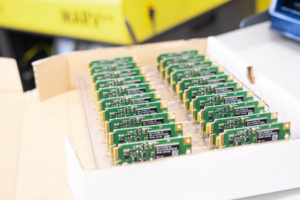The modem is one of the biggest energy guzzlers in M2M and Internet of Things components. As a result, the energy consumption during data transmission increases enormously. However, energy consumption in particular is a relevant characteristic in a large number of applications. Just think of the increasing number of various gadgets, wearables or smart home devices such as fire alarms or defibrillators in public buildings or companies. No fixed power supply is available in these applications. Nevertheless, the devices must function for a long time.
Separate architecture ensures low energy consumption
Due to the separation of modem and MCU, it is possible to put the modem into sleep mode without affecting the execution of the script. The modem is only switched on during a data transfer. The average power consumption of the rapidM2M M220 in interval mode can be reduced to 22μA. When using a D-cell in interval mode, this means a runtime of 8 years. Further modes are available. While in interval mode the data is transmitted at adjustable intervals, in wake-up mode a further transmission can be triggered at any time in addition to the regular intervals. Of course, this requires the modem to be ready to trigger a transfer from the server platform. The energy consumption here increases to 3mA. In online mode, the module constantly sends data and the modem is permanently switched on. This results in an average current consumption of 27mA.
Interchangeable components
As the uplink module or modem is separate from the MCU, it can be easily replaced. Data transmission is possible not only via GSM but also via LoRa or LAN, for example.
But the MCU is also interchangeable. rapidM2M M220 uses a 32-bit ARM Cortex-M3 MCU Due to the ARM architecture, the script is easily portable to other MCUs. The integrated flash memory is expandable. This means that even individual components can be customised precisely to the requirements of your applications.
rapidM2M PoC Shields for rapid testing
The rapidM2M PoC Shields provide you with various application interfaces to quickly develop an initial proof of concept (PoC). Plug your rapidM2M M220 module into the PoC shields and you are ready to start development. The PoC shields are available as a basic version and with a LAN, CAN, RS232 or RS485 interface.
The rapid development of a proof of concept is relevant for the further development of M2M, IoT and Industry 4.0 applications. In this way, successes can be demonstrated at an early stage of the project. With Microtronics, you can go from idea to proof of concept in just 3 weeks. As no in-house development is necessary, you minimise risks & costs and a faster market launch is possible. Microtronics supports you in developing a successful, profitable business model around your application.
Meet Microtronics at embedded world 2016
Microtronics will be presenting the Ultra Low Power technology and the complete rapidM2M system from 23 – 25 February 2016 in Nuremberg at embedded world, the world’s largest trade fair for embedded technology, and is looking forward to many visitors, exciting discussions and a look into the future of M2M.
Microtronics at the embedded world 2016 in Nuremberg
- When: 23 to 25 February 2016
- Wo: Nürnberg-Messe, Deutschland
Hall 5/Stand 248f



